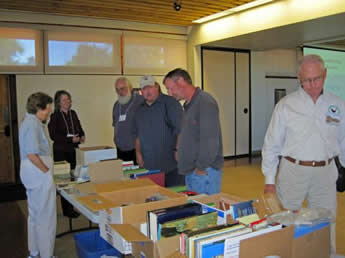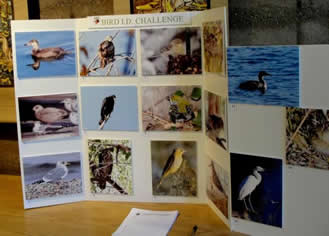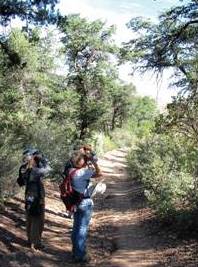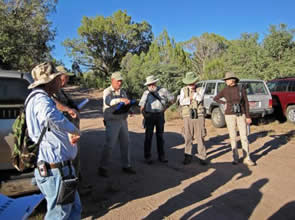Arizona Field Ornithologists
Fourth Annual State Meeting Moves AZFO Forward

By Doug Jenness
Nearly 60 participants at the fourth annual AZFO state meeting in Prescott, 8-10 October, enjoyed a stimulating program of presentations and reports on birdlife in Arizona, an excellent dinner, and five mini-field expeditions/workshops led by local enthusiastic birders. In his keynote talk at Saturday night's dinner, Carl Tomoff, Professor of Environmental Studies at Prescott College with nearly four decades of field experience in Arizona,described significant changes over the past 30 years in bird populations in the Prescott area.With an interesting set of slides, he described the relationship between many bird species and habitat changes.
On Saturday morning John Arnett, wildlife biologist for the 56th Range Management office at Luke Air Force Base, outlined the close relationship between a small wintering population of Gray Vireos and elephant trees in the southwestern part of the state. He reported that there are localities in that area that haven't been surveyed yet. He urged participants to join the AZFO field expedition 29-30 January in the Kofa Mountains to help survey these areas.
 The invasion of exotics, including crayfish, in the riparian habitats of the Verde River watershed is negatively impacting native fish and frog populations, reported Matt Johnson from the USGS Southwest Biological Science Center. This in turn is influencing the status of Common Black-Hawk which preys upon them along this drainage.
The invasion of exotics, including crayfish, in the riparian habitats of the Verde River watershed is negatively impacting native fish and frog populations, reported Matt Johnson from the USGS Southwest Biological Science Center. This in turn is influencing the status of Common Black-Hawk which preys upon them along this drainage.
Chris Dodge, a wildlife biologist with the Bureau of Reclamation and the Lower Colorado River Multi-Species Conservation Program, described efforts being made to restore some former agricultural lands along the Colorado River to native riparian woodlands thus encouraging nesting by Willow Flycatchers, Yellow-billed Cuckoos, and other riparian-nesting birds of concern.
As part of an aquatic bird nest colony inventory throughout the western United States, Troy Corman, AZFO president, reported statewide efforts are underway in Arizona to inventory heron, egret, ibis, and cormorant nesting colonies and count active nests. He urged birders who discover such colonies to contact him for an easy one-page data form.
Corman also reported on the annual North American Migration Count held the second Saturday in May, which is organized on a county by county basis. He especially appealed to birders in the northern counties, where participation has been limited, to join the count 14 May 2011.
Pierre Deviche reported that AZFO recently established the Gale Monson Research Grants which are available to anyone conducting field research that will enhance our knowledge of the status, distribution, identification, and other aspects of Arizona birdlife. There will be two $1000 grants available annually.


Corman announced the upcoming AZFO field expeditions, surveys and workshops. Details of each can be viewed at the Events page of the website.
Doug Jenness highlighted the achievement of establishing an AZFO logo, which was widely evident at the meeting, and recognized the contribution of Tucson birder Liz Payne in creating it. In appreciation, he reported, AZFO is establishing a special webpage about her. New AZFO polo shirts, caps, and cups with the logo sold well at the meeting with sales totaling $197.
Likely to become a tradition, the second annual used book sale drew a lot of interest and accounted for $281 in sales. The always popular bird photo ID contest was complemented this year with an audio contest. The prizes were donated by the Tucson Audubon Society's bookstore.
The membership elected officers and its Board of Directors. This included: Troy Corman, President; Marceline VandeWater, Vice President; Edwin Juarez, Recording Secretary; Doug Jenness, Treasurer; and Steve Ganley, Membership Secretary. Other Board members elected were: Janet Witzeman, John Yerger, and Lauren Harter. Editor Pierre Deviche, selected by the Board, is also a member.
Reports were also presented on AZFO's finances, website, and publications. Deviche noted that a big advance was made in the past year by providing two issues of AZFO News to members.
Jay's Bird Barn, the local Prescott natural history bookstore, set up a magnificent display of books and optical equipment that was highly appreciated by all participants. Nearly 30 meeting participants were from the Prescott and Flagstaff areas.
At the conclusion of the meeting Corman extended the AZFO's appreciation to David Moll and other local birders in the Prescott area who made the meeting such a success and to the staff of Prescott College which provided wonderful facilities and a delicious meal. He announced the next AFZO statewide meeting will be in the Phoenix area in October 2011.

After a stormy week, the weather cleared just in time for the AZFO annual meeting in Prescott. The weekend started with a Friday afternoon mini-expedition to Williamson Valley Wash and Pine Creek, about 25 miles northwest of Prescott as the crow flies. On Sunday morning, four groups fanned out. Two went locally, one going to Willow Creek Reservoir-woods and the other to Watson Woods-Lake, another traveled east to Mingus Mountain and Gaddes Canyon, and one traveled 25 miles southeast to Grapevine Creek. These trips included riparian habitats that run through agricultural, grassland, chaparral, pinyon-juniper, pine-oak, and mixed conifer habitats.

Duringthe weekend, 105 bird species were recorded plus Cassin's Kingbird and Horned Lark (and Rock Pigeon) supplemental to trip locations.
Highlights from Friday afternoon include American Crow (10) and perhaps the most unusual bird of the weekend, an out-of-range Verdin. With his usual encompassing yet detailed work, Walt Anderson and the Watson Woods-Lake group had the most bird species (54) of any trip that weekend. They were able to tease out the lone Cinnamon Teal and contribute species such as Peregrine Falcon, Lesser Yellowlegs, Barn Owl, House Wren, and Cedar Waxwing. The Willow Creek Reservoir-woods group had almost as many bird species unique for the weekend (12) counting the central Arizona specialty Wood Ducks, distinguishing the lone Lesser Scaup, and adding Bald Eagle, American Avocet, and Marsh Wren.

The weather on Mingus Mountain was unaccommodating with high winds that faded only slowly through the day. Nonetheless, that group supplied Band-tailed Pigeon, Steller's Jay, Brown Creeper, and Pine Siskin to the overall effort with one highlight being a male Williamson's Sapsucker. Grapevine Creek had the most species unique to the weekend (15) including Cassin's and Hutton's Vireos, Crissal Thrashers, a lower elevation than expected Olive Warbler, Green-tailed Towhee, Black-chinned and (Slate-colored) Fox sparrows, Black-headed Grosbeak, Cassin's Finches and yet another attractive male Williamson’s Sapsucker.
Thirty-five people participated in the five field expeditions and workshops. The number of participants and number of trips were greater than for any of the previous AZFO state meetings.